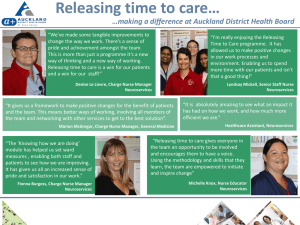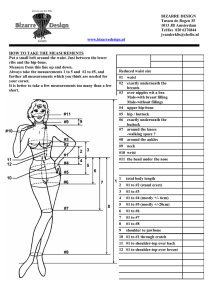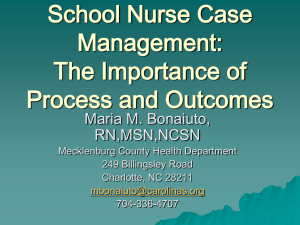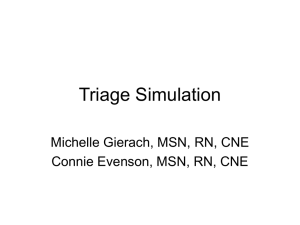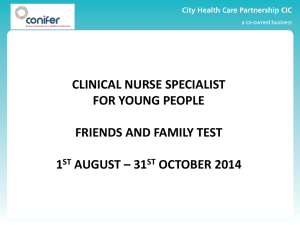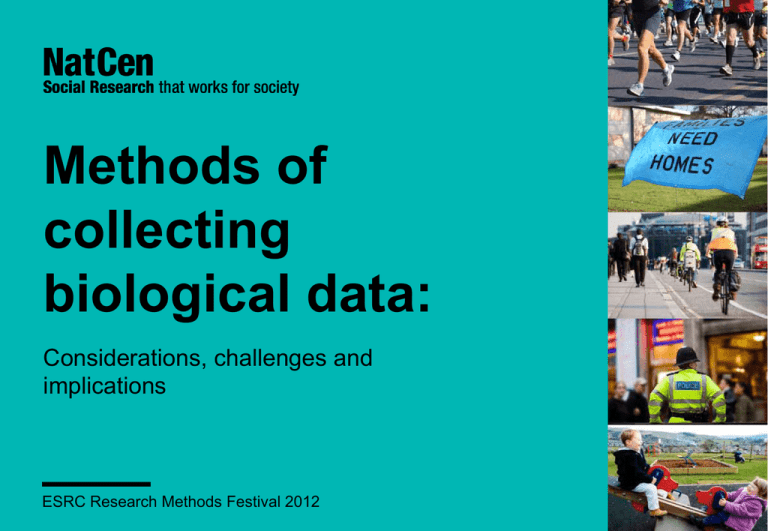
Methods of
collecting
biological data:
Considerations, challenges and
implications
ESRC Research Methods Festival 2012
Why collect biological measures?
Undiagnosed
diabetes
Early kidney
disease
Vitamin D
levels
Dietary salt
levels
Passive smoking
Prevalence of STDs
Risk of CVD
Genetics
1
Our experience of
collecting biological
measures
What have we collected?
Measurements
• Height and weight
• Waist and hip
• Arm circumference
• Demi-span
• Grip strength
• Walking speed
• Infant head circ.
• Cognitive tests
• Balance
3
Medical measures
• Blood pressure
• ECG
• Lung function
• Dental checks
•Step tests (fitness)
Samples
• Venous blood
• Blood spots
• Saliva
• Urine samples
• 24 hour urine
• (Tracer water)
• Hair
Who should
collect what?
2.
Our traditional approach
Standard
interviewer visit
+ some
measures
(height and
weight)
Interviewer
introduces
nurse visit, may
make
appointment
Nurse follow up
visit at
participant’s
home to collect
other measures
• NatCen first used nurses in 1994 Health Survey for England
• Requires a special panel of freelance nurses (we have around 150)
5
Drawbacks of nurse follow ups: drop out
Survey
% of interviewed
who have nurse
visit
HSE 2010 (adults)
71% (5,587 visits)
NDNS Yr 3
6
74% (698 visits)
ELSA wave 4
86% (8,218 visits)
US (W2Y2 + W3Y1)
65% (4,409 visits)
Nurse HSE sample
very similar to
interview:
Slightly fewer
smokers and nondrinkers (esp. men).
Little difference by
Age; sex; BMI;
general health; diet.
Slightly more:
Men with high BP
We have used interviewers to collect…
•
•
•
•
•
•
•
•
•
7
Height
Weight
Waist
Saliva sample
Urine samples
Timed walks
Infant length & head
circumference
Grip strength
Cognitive tests
And recently developed
protocols to extend
interviewer biomarker
collection to:
•Blood pressure
(Scottish Health Survey)
•Dried blood spots
(Scottish Health Survey from
2013)
Drawbacks of nurse follow ups: logistics
Paediatric
phlebotomist
NDNS
Interviewer
visit
Nurse visit
(74%)
Child fasting
blood (35%)
Adult fasting
blood (69%)
Child 24 hr urine
(74%)
Adult 24 hr urine
(80%)
• NDNS requires clinics within two hours of each sample point
• Specialist phlebotomists for some visits
8
Blood to lab within
2 hours for
spinning
Use of clinics
Diet and Nutrition Survey of Infants and Young Children
• Blood taking from 4 – 18 month olds, immediate spinning of blood
• Feed special tracer water to these infants, specific dose
• Skinfold measures
Decision to use clinic-based follow-up:
• 20 clinics recruited (hospital/private), specific
training for staff
• 2 mobile vans with experienced staff (initially for
people living far from a clinic)
9
Clinic response
Skinfold measure
(99%)
Interviewer
visit
Clinic visit
(44%)
Blood (55%)
“Tracer water”
taken (86%)
10%
51%
39%
Allocated Mobile unit/Attended
Mobile unit
Allocated hospital/Attended
Mobile unit
Allocated hospital/Attended
hospital
10
Does it matter who takes
the measurements or
how they take it?
…evidence from the Scottish Health
Survey
Large scale survey monitoring the health of the
12
Scottish population
Carried out 1995, 1998, 2003 and annually since
2008
Collecting biomeasures using the traditional nurse
model since 1995
Switched to using field interviewers in 2012
What impact, if any, will this move have on our ability
to continue to monitor trends in…
Mean waist measurement, 1995 2010
cm
110
100
?
90
?
80
Women
70
60
50
20
11
20
10
20
03
20
08
/9
19
98
19
95
40
13
Men
…waist measurements
move to a different (less invasive) protocol
14
Blood pressure level, 2008-2010
50
% hypertension
40
?
30
?
Men
Women
20
10
0
1998
15
2003
2008/9
2010
2011
…blood pressure
•Protocol unchanged
•Concerns about non-medically
trained interviewers collecting it
•Interest in whether “white coat
syndrome” extends to nurses
16
Validation study objectives were…
1. To establish the degree of correlation
between interview and nurse measurements
2. Generate calibration equations that allow for
SHeS statistics to be ‘converted’
17
How did we do it?
Paired up trained field interviewers and survey
nurses (15 pairs)
Pairs visited respondent in own home, taking turns
to take BP readings & waist measurements
Purposive sample – oversampled aged 55+
300 paired interviews carried out (Mar-May 2012)
18
Factors considered
•
Order of interviews was randomised
•Carried out consecutively
•Partner not in the home at time of interview
•Same blood pressure machine used
•Participant told whether an interviewer/nurse
•Results from 1st visit not given to participant
19
Interview content
Interviewer visit
Nurse visit
1. Blood Pressure
1.Blood pressure
2. Waist measurement
2.Waist measurement (own
protocol)
3.Waist measurement
(interviewer protocol)
20
So did it matter who
took the
measurements &
how?
Biomarkers – things to consider
It is possible to collect a range of biological measures within a
survey based study, but it is important to consider how:
Who will collect (interviewer, nurse, clinic, self):
Complexity of measure, protocol, acceptability, analysis
requirements, target population
Ethical considerations
Training is vital – quality is important!
Equipment: ease of use, portability, durability
Labs – work with them to agree protocols, check quality!
Data analysis – can be a minefield.
22
Thank you
If you want further information or
would like to contact us
Lisa Rutherford
Research Director
T. +44 (0)131 221 2555
E. lisa.rutherford@scotcen.org.uk
Visit us online, natcen.ac.uk

